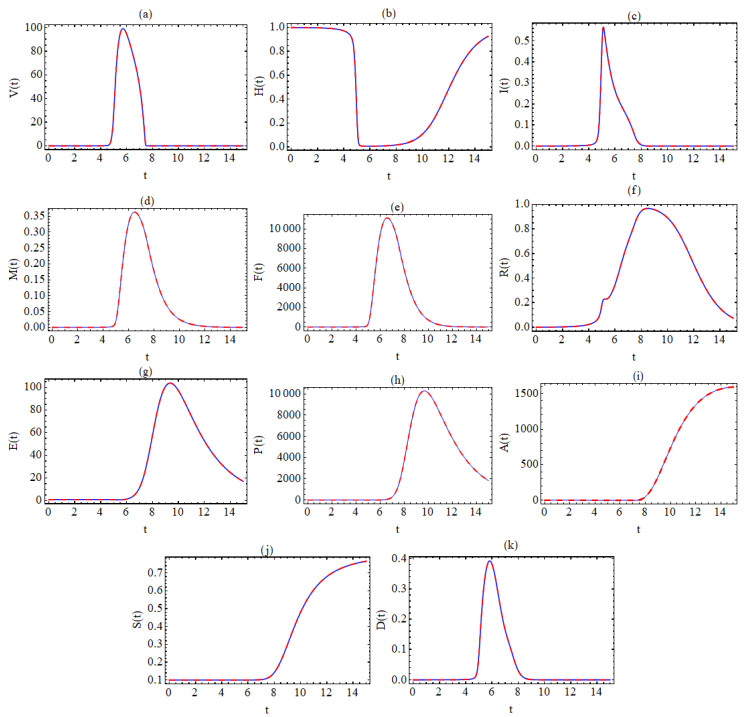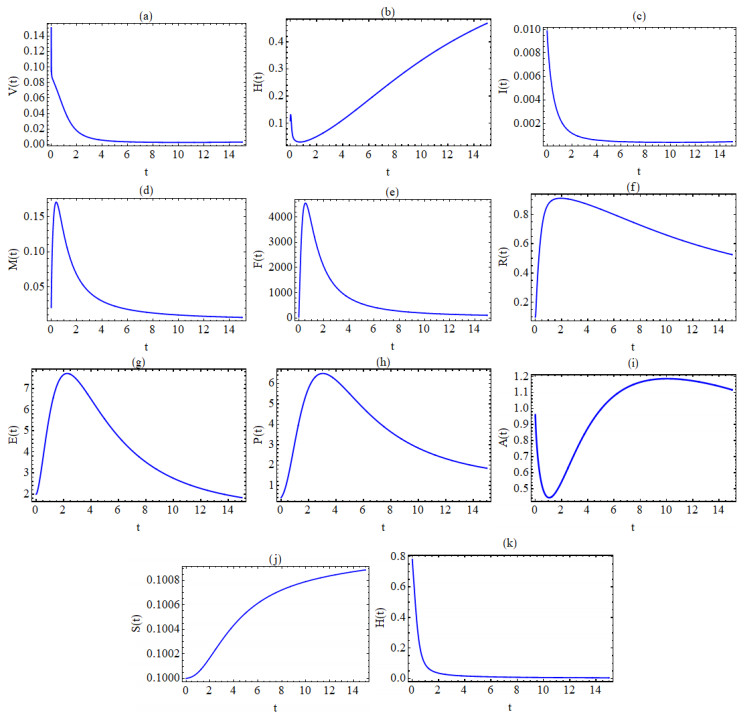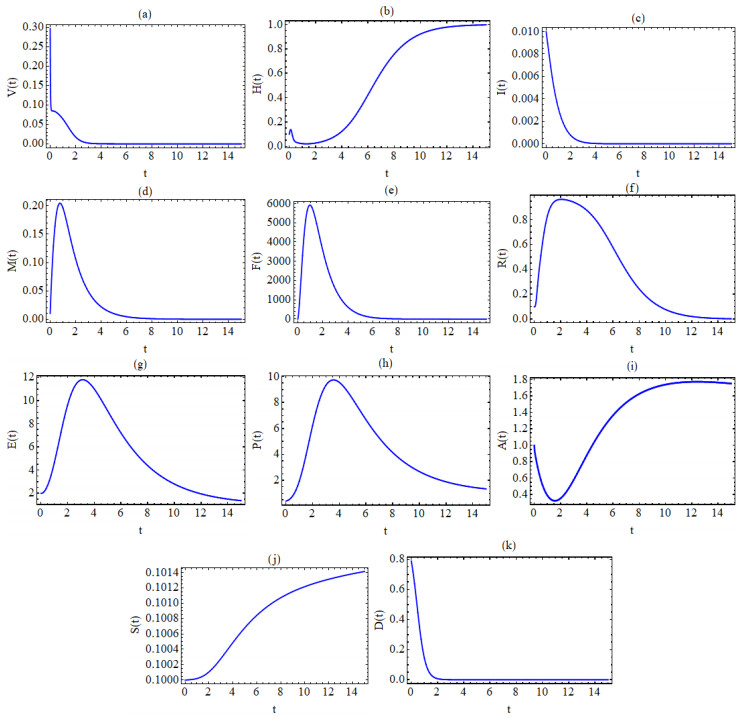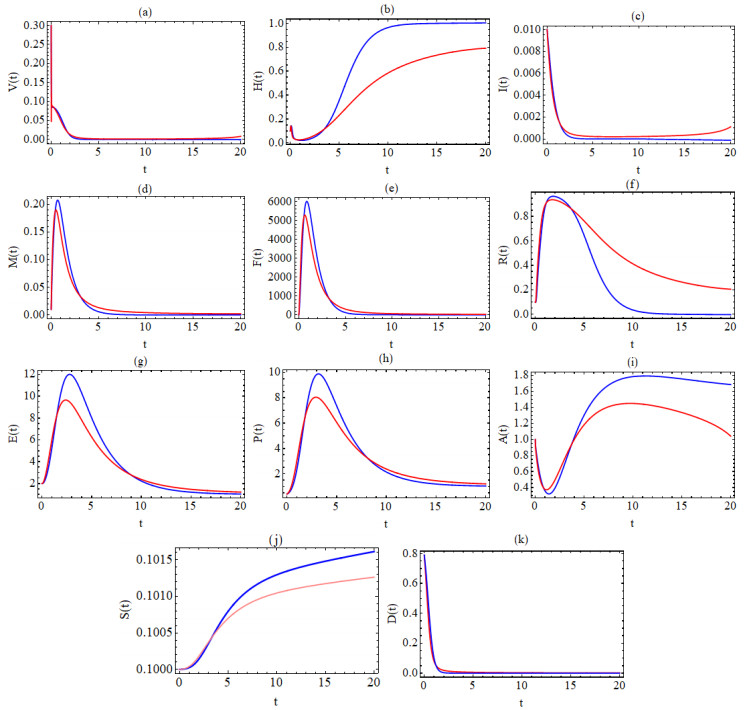Fractional derivative operators of non-integer order can be utilized as a powerful tool to model nonlinear fractional differential equations. In this paper, we propose numerical solutions for simulating fractional-order derivative operators with the power-law and exponential-law kernels. We construct the numerical schemes with the help the fundamental theorem of fractional calculus and the Lagrange polynomial interpolation. These schemes are applied to simulate the dynamical fractional-order model of the immune response (FMIR) to the uncomplicated influenza A virus (IAV) infection, which focuses on the control of the infection by the innate and adaptive immunity. Numerical results are then presented to show the applicability and efficiency on the FMIR.
1.
Introduction
Mathematical modeling of the spread of infectious diseases has attracted much attention of researchers in various disciplines. The importance of the modeling is that it has become an important tool in understanding the dynamics of diseases and in the decision-making process with regard to rapid intervention programs in controlling and limiting the spread of these diseases [1,2,3,4,5,6,7]. Until mathematical tools are employed, real-world problems were modeled by means of an abstract model. These mathematical models contain basic variables and relationships corresponding to the observed and recorded phenomena and behavior. Due to the fact that the theory of differential equations is not sufficient to describe and model many real-world and complex problems, the critical importance of fractional differential equations appears in modeling these issues in recent years [8,9,10,11,12,13,14,15,16,17,18]. Furthermore, owing to its many widespread applications, scientists and researchers have significantly attracted the attention toward fractional differential equations. Accordingly, many models of differential equations containing fractional differentiation and fractional integration have been developed. And the fact that, for many fractional differential equations, it is difficult to find the exact solutions, so it has become very important to develop and update numerical methods so that we can find approximate and numerical solutions to many of these equations [19,20,21,22,23,24,25,26,27,28].
The Adams-Bashforth predictor-corrector method has been proposed [29,30,31,32,33,34,35], as a great and powerful numerical method which is capable of providing a numerical solution of fractional differential equations. The method can be used for linear as well as nonlinear fractional differential equations.
In this paper, we derive and discuss the numerical solutions of the fractional-order model of the human immune response to influenza A virus (IAV) infection by using the method that was proposed in [36], which combines the fundamental theorem of fractional calculus and the two-step Lagrange polynomial. The authors in [37] proposed a simplified dynamical model of immune response to uncomplicated influenza A virus (IAV) infection. This model focuses on the control of the infection by the innate and adaptive immunity [37]. Zhang et al. [38] propped a long review on hostvirus interaction: How host cells defend against Influenza A Virus Infection. They presented a general description on recent work regarding different host cells and molecules facilitating antiviral defenses against IAV infection and how IAVs antagonize host immune responses. Also, Vires et al. [39,40,41] discussed in details on the factors for influenza A virus infection, Preserving Virus Motility, IL16 deficiency enhances Th1 and cytotoxic T lymphocyte response against influenza A virus infection. In our paper, we focus on studying the effect of the change of the integer-order derivatives and non-integer derivatives with power and exponential kernels.
The paper is organized as follows. Notations and basic definitions of fractional derivatives are given in Section 2. In Section 3, the classical model of immune response is presented. In Section 4 and 5, the numerical method with power and exponential laws is discussed and illustrated graphically. Finally, conclusions are summarized in Section 6.
2.
Preliminaries
In this section, we give some basic definitions and properties of fractional calculus theory [2,3,43,44].
Definition 1. If Y(t)∈L1(a,b), the set of all integrable functions on (a,b), and α>0, then the Riemann-Liouville fractional integral of order α, denoted by Jαa+ is defined by
Definition 2. For α>0, the Liouville-Caputo fractional derivative of order α, denoted by LCDαa+, is defined by
where D=ddt.
We next introduce the Caputo-Fabrizio-Caputo fractional integral operator of order α>0 [45].
Definition 3. The Caputo-Fabrizio-Caputo derivative operator (CFC) with respect to t, denoted by CFC0Dαη, is defined by
where M(α) is a normalization function such that M(0)=M(1)=1.
Definition 4. Losada and Nieto [45] proposed the fractional integral according to the CFC as follows:
3.
Classical immune response
3.1. Mathematical formulation
In this section, we will first provide remarkably simple details about the composition and the basis on the model of human immune response to influenza A virus (IVA) infection. For further details and for the history of this virus infection, we refer the reader to the earlier work [37].
The human immune response model against the IVA infection has been found to be a simplified population dynamic model consisting of the following interactions. Figure 1 shows the schematic representation of interactions included in the model [37]. Respiratory system epithelial cells are presumed to be present in one of these four possible states: Healthy (H), infected (I), dead (D), or resistant (R) to infection. Total epithelial cell count (that is, H + I + D + R) is believed to be constant. The particles of the virus (IAV) interact with and infect healthy cells. Once these virus particles die, the infected cells release new virus particles. Proliferation of healthy cells causes regeneration and the proportion of dead cells decreases. APS stimulates interferon a and b (F) production which interacts with healthy cells and converts them to a resistant state. In addition, APS stimulates the proliferation of effector cells (E) which kill the infected cells.
Finally, they stimulate production of the plasma cell (P). This, in turn, produces antibodies (A) to neutralize the virus. The antigenic compatibility (S) between the virus and the antibodies currently generated by the organism modulates the neutralization. S quantifies the interaction of the antibodies with the virus. In order to illustrate the components of the immune response as shown in Figure 1, we will use the previous interactions to construct a system of ten differential equations describing the dynamics of the main variables.
and
We impose the following initial conditions:
where V,H,I,M,F,R,E,P,A and S are Viral load per epithelial cell, proportion of healthy cells, proportion of infected cells, activated antigen presenting cells per homeostatic level, interferons per homeostatic level of macrophages, proportion of resistant cells, effector cells per homeostatic level, plasma cells per homeostatic level, antibodies per homeostatic level and antigenic distance, respectively.
3.2. Description of the involved parameters
The above parameters are defined in the following table:
4.
Immune response with fractional-order derivatives
In this section, we present a generalization of the numerical schemes proposed in [36] for the fractional immune response involving the Liouville-Caputo and Caputo-Fabrizio-Caputo fractional-order derivatives.
The fractional immune response model is obtained by replacing the classical derivative by the operator 0Dαt
and
The numerical solution to the system given by Eqs (4.1)–(4.10) is obtained by applying the following numerical algorithms.
4.1. Numerical scheme for fractional immune response in LC sense
Involving the LC derivative, we have
and
Now, by applying the fundamental theorem of fractional calculus on Eqs (4.11)–(4.20), we obtain
and
Equations (4.21)–(4.30) can be reformulated as follows:
and
Using the two-step Lagrange polynomial interpolation, we obtain
and
These integrals are evaluated directly and the numerical solutions of Eqs (4.11)–(4.20) involving the LC derivative are given by
and
4.2. Numerical scheme for fractional immune response in CFC sense
Considering the CFC derivative, we have
and
As in the preceding section, by applying the fundamental theorem of fractional calculus, we obtain
and
where M(α) is a normalization function such that M(0)=M(1)=1.
We now complete the procedure with one equation and, for the remaining equations, we repeat the same procedure to get the final constructions of approximation iteration. First, we let t=tn+1
Then t=tn and
Thus, in view of Eqs (4.83), (4.84), we obtain
In view of the Lagrange polynomial interpolation, and by integrating the following expressions, we obtain
After some manipulation, we have the following expression:
Following the same procedure as in the case of LC, we find that
and
5.
Numerical simulations
In this section, we present numerical simulations of the model given by the systems given by Eqs (4.1)–(4.10), and (4.63)–(4.72). We study the dynamical behavior of the model for variation of the integer-order derivative and non-integer α. The basis of the selection of the parameter values are shown in [37]. In our investigation, we have concentrated upon the case that the host has no dead, infected or resistant cells, no interferon molecules, and no activated APC so that h0=1,i0=m0=f0=r0=0). The initial levels of effectors, plasma cells, and antibodies are assumed to be at the homeostatic values (that is, e0=p0=a0=1) [42]. The initial antigenic compatibility is s0=0.1 and the initial virus particle v0=0.01. Now our focus is on studying the effect of the change of the integer and non-integer derivatives on the behaviour of the numerical solutions. For the the effects of biological behaviour for this model [42].
First of all, in Figure 2, we clarify the comparison between the solutions presented in this paper with those derived by using known numerical methods such as finite difference methods (FDM) in the case of α=1. Of course, the numerical solutions based on the two operators LC and CFC in the case when α=1 are identical, so the comparison will be done once. We set the initial and parameter values as v0=0.01,h0=1,i0=0,m0=0,f0=0,r0=0,e0=1,p0=1,a0=1,s0=0.1γV=510,γVA=6192/10,γVH=102/100,αV=17/10,aV1=100,aV2=23000,bHD=4,aR=1,γHV=34/100,bHF=1/100,bIE=66/1000,aI=15/10, bMD=1,bMV=37/10000,aM=1,bF=250000,cF=2000,bFH=17,aF=8,bEM=83/10,bEI=272/100,aE=4/10,bPM=115/10,aP=4/10,bA=43/1000,γAV=1462/10,aA=43/1000 and r=3/100000. These initial values and parameters were taken as in [37].
From Figure 2 it is clear that our results are consistent with those derived by the known numerical method as well as those with the results in [37]. Now we focus on the fraction α values which are the aim of our paper. Figures 2 and 3 illustrate the behavior of the numerical solutions based on the LC and CFC operators, respectively. In Figure 3 the numerical solutions based on the LC operators are displayed against time (days) for the initial values v0=0.2,h0=0.1,i0=0.01,m0=0.01,f0=0,r0=0.1,e0=2,p0=0.4,a0=1,s0=0.1 and for the same parameter values as those in Figure 2. In Figure 4 the numerical solutions based on the CFC operator are plotted against time for the similar data as in Figure 4. Figure 5 shows the behavior of the numerical solutions based onto the LC and CFC operators with α=0.9.
We note from Figure 5 that the two solutions exhibit the same behavior at the time of getting started and also at the steady state as t approaches to a large time.
6.
Conclusions
In our present investigation, we have considered the model of immune response to uncomplicated influenza A virus (HIV) infection, the discussion of which was initiated in [1]. The novelty of the presented work is in the construction of a new algorithm for the fractional-order system of human immune against HIV infection. To the best our knowledge, this is the first study for this fractional-order model. Here, in this paper, we have replaced the ordinary derivative by the Liouville-Caputo (LC) and Caputo-Fabrizio (CFC) fractional-order derivatives. We have constructed the scheme for these operators according to the fundamental theorem of fractional calculus and the two-step Lagrange polynomials. Numerical simulations are carried out by using these schemes.
The accuracy of the numerical solutions was verified for our usage of the proposed method by closely comparing our numerical solutions with the numerical solutions resulting from the use of the computer program package, Mathematica, and also with those in [37]. Excellent agreement has been found. The behavior of the numerical solutions for LC and CFC are also illustrated graphically.
Some useful highlights of our present investigation are being itemized below.
● The proposed methods have many applications and are widely used because of their good properties in the process of approximation.
● The methods used include a numerical technique with high accuracy, which is easy to use for other problems as well.
● The numerical solutions have the same behaviour when the order of the derivative varies from non-integer order to integer order.
● For future work, it is possible to extend these studies to the fractal-fractional derivatives involving different operators.
● For the interest and motivation for further researches on the subject of this paper, we have chosen to cite a number of recently-published related works [4,5,6,25,26,27,46,47,48,49,50,51,52].
● These recent works proposed and made use of many different methods and techniques for solving various families of fractional differential equations.
Acknowledgements
J. F. Gómez Aguilar acknowledges the support provided by CONACyT: Cátedras CONACyT para jóvenes investigadores 2014 and SNI-CONACyT.
Conflict of interests
The authors declare that there is no conflict of interests regarding the publication of this paper.
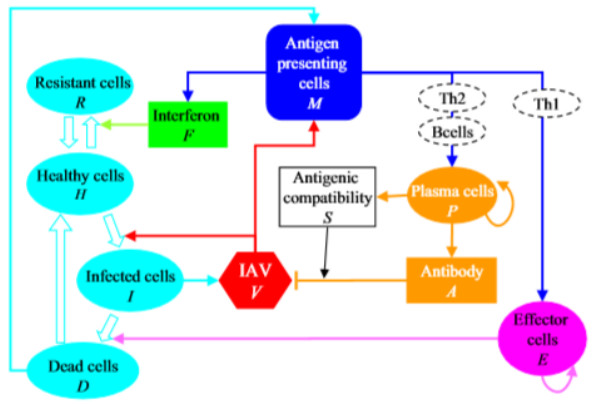









 DownLoad:
DownLoad:
